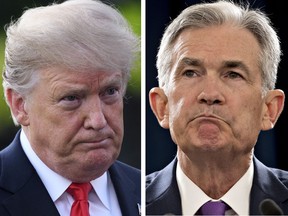‘Crazy’ Federal Reserve is getting 'too cute’: Trump slams Fed in run of invective unusual even for him
He has called the Fed ‘crazy,’ ‘loco,’ ‘ridiculous,’ and ‘too cute,’ while saying its rate increases are ‘too aggressive,’ and ‘a big mistake’

Article content
WASHINGTON — U.S. President Donald Trump launched a second day of criticism against the Federal Reserve on Thursday, calling its interest rate increases a “ridiculous” policy that was making it more expensive for his administration to finance its escalating deficits.
“I’m paying interest at a high rate because of our Fed. And I’d like our Fed not to be so aggressive because I think they’re making a big mistake,” Trump said in a Thursday morning interview on Fox & Friends.
It was his second broadside against the U.S. central bank in the last 24 hours, following a sell-off on Wall Street partly attributed to investors fully adjusting to the central bank’s steady rate increases, and an uptick in particular in yields on long-term U.S. Treasury bonds that are an important, more secure alternative to stock investments.
Past presidents have criticized their central bankers, but this was an unusual run of invective even for Trump. Since the close of Wednesday’s trading session on Wall Street he has called the Fed “crazy,” “loco,” “ridiculous,” and “too cute,” while saying its rate increases are “too aggressive,” and “a big mistake.” U.S. stocks opened lower on Thursday.
“The problem that I have is with the Fed. The Fed is going wild. I mean I don’t know what their problem is but they are raising interest rates and it’s ridiculous,” Trump said late Wednesday night.
“The problem in my opinion is Treasuries and the Fed. The Fed is going loco and there is no reason for them to do it and I’m not happy about it.”
Trump went on to blame an “out of control” U.S. central bank for Wednesday’s stock market sell-off when he spoke to reporters in the Oval Office Thursday morning.
Trump told reporters that he knows monetary policy better than the Fed’s leaders and continued criticizing them for interest-rate increases.
“The Fed is out of control,” Trump said. “I think what they’re doing is wrong.”
The president added that the Fed’s interest rate increases are “not necessary in my opinion and I think I know about it better than they do.”
“I’m not going to fire him,” Trump said Thursday of Powell, a Trump appointee who legally can only be fired for cause. “I’m just disappointed at the clip. I think it’s far too fast, far too rigid.”
Trump said the market plunge is “a correction that I think is caused by the Federal Reserve.”
A Fed official said the central bank would not comment on the president’s remarks.
Global economic leaders including International Monetary Fund head Christine Lagarde came to the Fed’s defense, noting that the independence of monetary policy from the influence of elected officials has become a touchstone of effective economic governance, and helps prevent politicians from using cheap money to further their own interests. At IMF meetings in Bali, Lagarde said she “would not associate” Fed chair Jerome Powell “with craziness.”
The Fed raised interest rates last month, and is expected to do so again in December. Fed officials including Powell, Trump’s handpicked chair, have said pointedly that they will not be influenced by comments from elected officials, and will make decisions based on economic data.
That has so far been strong enough to warrant steady rate hikes, a sign from the Fed’s perspective of an economy that has recovered more completely from the 2007 to 2009 financial crisis. At just over 2 per cent, the Fed’s short-term policy rate remains low by historic standards, and most indexes of borrowing costs and credit flows still regard broader financial conditions as “loose” and conducive to economic growth.
The yield on the 10-year U.S. Treasury note has risen to around 3.1 per cent from around 2.1 per cent over the past year.
The gradually rising rates, Fed officials say, are meant to guard against any quick run-up in inflation, while remaining low enough so far for the recovery and a strong run of job growth to continue.
The policy could eventually bite harder into parts of the economy that are both sensitive to interest rates and connected to politically important industries, such as autos and home construction and sales.
With file from Bloomberg
© Thomson Reuters 2018






Postmedia is committed to maintaining a lively but civil forum for discussion. Please keep comments relevant and respectful. Comments may take up to an hour to appear on the site. You will receive an email if there is a reply to your comment, an update to a thread you follow or if a user you follow comments. Visit our Community Guidelines for more information.